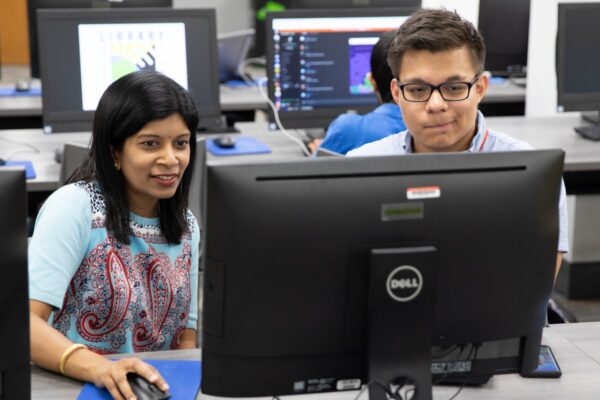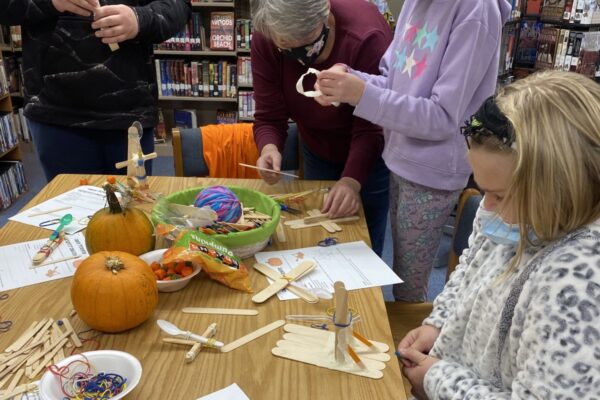Computational Thinking is the New Literacy of the 21st Century—Are Students Prepared?
Computational thinking (CT), the concepts and practices associated with using computers and technology to solve problems, is becoming one among many new literacies of the 21st century and is increasingly considered a critical skill for academic and career success. Urban, rural, and at-risk youth are often in school systems that are least able to provide comprehensive CT education, and they are unlikely to have the resources or support to learn these skills at home despite arguably being the population who could most benefit from them. Libraries have stepped in to provide CT educational programs for these youth.

Dr. Mega Subramaniam and research team staff member review CT program assessment tools. Image credit: Craig Taylor.
“In places where technology infrastructure and access to computing is lacking, libraries are playing that role to help youth get CT content,” says University of Maryland College of Information Studies Professor Mega Subramaniam. However, libraries have had little centralized guidance on how to assess if their programs are actually having an impact. “Library staff really want to assess their programs, but they are stretched thin. There are so many programs that they offer to their community. The challenge is how library staff can assess quickly and learn to make their programs better,” says Subramaniam.
Now that’s possible with an easily accessible, new suite of assessment tools from Subramaniam and the IMPACT Libraries research team. The tool was designed and developed with input from 70 library staff from around the country and assesses CT skills, conceptual learning, dispositions, confidence, preparation for future learning or career, positive experiences, and access and equity.
A Closer Look at CT
CT is a problem-solving technique that involves breaking down complex problems into smaller pieces that a computer can understand. It is a fundamental skill that helps individuals create efficient algorithms, design computer programs, and develop solutions to real-world challenges. At its core, CT involves four main areas—decomposition, pattern recognition, abstraction, and algorithmic design.
Decomposition is the process of breaking down a complex problem into smaller, more manageable pieces that can be tackled one at a time.
Pattern recognition involves looking for patterns and similarities within a set of data. This helps individuals identify common themes and begins to highlight regions in which a solution is required. It also enables individuals to eliminate irrelevant information.
Abstraction involves identifying the essential elements that make up a problem and categorizing them so that they are easier to work with.
Algorithmic design is the process of devising a plan or solution to a problem by breaking it down into a sequence of smaller steps, leading to the development of efficient solutions that can be easily implemented.

Youth work on a Halloween-themed STEM project at the Linesville (PA) Public Library. Image credit: Renee Grout.
CT is critical in today’s digital age. It enables individuals to solve complex problems, identify patterns, focus on essential information, and develop efficient solutions. Learning CT can start at a young age and some concepts can be taught without a computer.
For example, a group of preschoolers might sit cross-legged on a mat with a variety of shapes printed on it. The librarian reads aloud from a book about shapes. When the story is finished, the librarian plays music and encourages the children to dance and jump from one shape on the mat to another and create a pattern. As the children enjoy themselves, they are learning pattern recognition, which contributes to CT literacy.
How the Assessment Tool Works
The suite of assessment tools is easily accessible and is organized by outcomes that match the goals of CT library programs : CT skills, conceptual learning, dispositions, confidence, preparation for future learning or career, positive experiences, and access and equity. For example, for CT dispositions, a library staff can use the dispositions checklist, which is an observational tool that will help library staff identify CT dispositions (perseverance, tolerance to ambiguity, and collaboration) among youth in a given team task. For CT conceptual learning, staff can use a rubric that assesses computational thinking concepts and principles that are captured in any youth-designed project (games, apps, code writing, etc.).
Some outcomes are best assessed using talkback boards – a digital or paper poster or whiteboard with prompts and simple statements designed to obtain quick feedback from youth. Some outcomes are best measured using build-your-own interview protocol, a flexible tool that allows library staff to create and customize a set of questions that they find most useful. The questions will help them gain immediate feedback and insights from the youth that participate in the programs. Additionally, each tool comes with analysis sheets, a facilitator guide, and other documents that can be copied, shared, or printed out.
Most CT assessment tools are designed for schools, but library programs are different. For instance, there are no high-stakes tests to pass or fail. “Failure is embraced and encouraged. That’s very important when you’re learning CT because you will make a lot of mistakes as you learn,” says Subramaniam. In school, youth aren’t given the same amount of time and space to learn from mistakes; teachers have a lot of material to cover and move through lessons at a brisk pace.
Libraries are often more flexible than schools. Youth might come in for a CT program every week for a few months or do a more intensive course over spring break. Most significantly, library programs are driven by childrens’ interest, not a particular test they’re meant to prepare for.
Assessment tools designed specifically for libraries help library staff evaluate what’s working and be able to revise their programs. They can also demonstrate the impact of their programs using data to their board of trustees, donors, and supervisors. This enables library staff to justify receiving more funding or consider whether to put resources elsewhere.
“Maybe libraries will use the data in ways we have not imagined,” says Subramaniam.










